#anti disneys rapunzel
Text
Rapunzel fans talk shit about jasmine, saying that she doesn't even have her own movie. However, these same fans forget that rapunzel was sidelined in her own movie for some sexist bullshit. Disney was trying hard to make Tangled marketable and changed the protagonist to Flynn instead of Rapunzel. At least it made sense for them to focus on Aladdin, the movie is based on Aladdin and the magic lamp. Tangled was based on Rapunzel, and Disney reduced her as a plot device in HER story.
#mine#anti tangled#anti tangled stans#anti disneys rapunzel#tangled critical#tangled criticism#anti Disney rapunzel
22 notes
·
View notes
Text
I think there's something deeply symbolic about how Mother Knows Best, the song about Rapunzel's mom manipulating and sheltering Rapunzel so she can use her for her own benefit, being shot in the dark, with Gothel snuffing out Rapunzel's every attempt to light a candle, meanwhile, the song about Rapunzel realizing that her dreams are not out of reach— that love is real and that she can be truly loved— is called At Last I See The Light."
#tangled#new dream#anti mother gothel#rapunzel#euegen fitzherbert#disney#otp: all at once everything looks different
326 notes
·
View notes
Text
Why are these Disney heroines "adorkable"?

Rapunzel (Tangled): Because she was raised in isolation her entire life. She doesn't have a clue about the outside world or social graces or other people besides her "mother" in general. But she's extremely eager to learn and eager to please, not to mention is a pent-up ball of energy waiting to run wild, which leads to her adorkability. It makes perfect narrative sense.
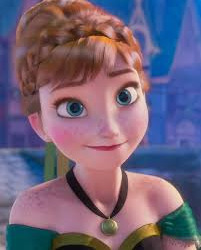
Anna (Frozen): While not as badly as Rapunzel, she was also raised in isolation for much of her life, largely having to rely on the books in her castle library to teach her about the world and things such as proper etiquette, life skills and romance. But real life is not a book, so when she actually has to do these things, she often flounders due to her nervousness, excitement or inexperience, which leads to her adorkability. It makes perfect narrative sense.
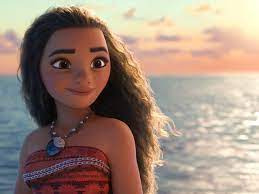
Moana (Moana): From early in her life, she was raised under a very strict set of rules and instilled with a strong sense of responsibility, which is at odds with her instinctive desire to break these rules and her fears that she isn't up to the challenge her responsibilities pose. All of this pent-up stress she carries within her will often cause her to explode with emotion at the slightest provocation, which leads to her adorkability. It makes perfect narrative sense.
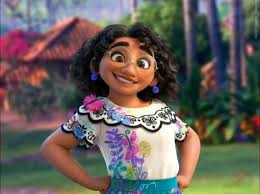
Mirabel (Encanto): As a young child, she failed to receive a special gift and room the same way the rest of her family did. Now feeling like the failure of the family, Mirabel's coping mechanism became trying to make herself as extravagant and quirky as possible. She's an incredibly "Try Hard" person, which leads to her adorkability. It makes perfect narrative sense.

Asha (Wish): Um.....well, she.....yeah, I got nothing. There is no narrative justification here.
Disney doesn't have an Adorkable Problem. Just an Asha Problem.
#Disney#Female Characters#Tangled#Rapunzel#Frozen#Anna#Moana#Encanto#Mirabel Madrigal#Wish#Asha#Analysis#Comparison#Bad Writing#Anti-Wish#Anti-Asha
237 notes
·
View notes
Text
Varian: Hey Disney.
Disney: Huh. What is it, Varian?
Varian: Where's the spin-off, Disney? You would pass it on.
Disney: We changed our minds. You are too grating, annoying, selfish and a whiny brat for the audience to look at. And not because you're a Rapunzel-related character, reasons we scrapped a spin-off for you.
Varian: Bruh, I changed.
#tangled the series#rapunzel's tangled adventure#varian and the 7 kingdoms#varian the alchemist#tangled varian#tts varian#rta varian#varian and the seven kingdoms#varian vat7k#anti disney
18 notes
·
View notes
Note
I was reading your "Return of Rapunzel" salt review. You disliked Rapunzel and the gang did not feel any concern or compassion for Varian being imprisoned or did not notice or care Varian was being used by the Saporians. And I hate to ask this but, why would they care? Eugene watched this kid attack the love of his life with a MACHINE and if it weren't for her powers, would have killed her. Rapunzel watch him almost crush her mom and best friend. Even good people have limits on compassion.
They should care because
1. It's their own damn fault for not doing thier jobs
2. It's thier fucking jobs!
3. He is a child!
4. Punitive punishment is not help; it's abuse
5. Any decent human being should have cared long before it got this bad but Rapunzel is devoid of humanity in this show because she's written by a Nazi
Thanks for coming to my Ted talk.
36 notes
·
View notes
Text



Intro take 2 lol uh i actually figured out i'm not bigenderfluix so lets try this intro post again!
Hi there! I'm Rapunzel i'm a fictive from the movie tangled I am girlboyflux, pan and I use she/he/sun pronouns!
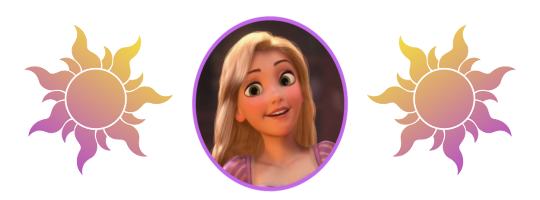
#alter intro#fictive#disney fictive#rapunzel#tangled#anti endo dni#traumagenic system#pro endo#fictive intro#girlboyflux#plural#plurality#plural system#actually plural#intro take 2#intro post#mogai community
21 notes
·
View notes
Text
gonna start blocking people who tag my posts as rwde you and i are not the same
#throwback to the tts fandom where i could literally b like#it’s fucking awesome that tts let raps be messed up i love that she’s a fully rendered human being instead of a Disney Princess#and then watch it do rounds with the moonvarian people tagging it anti rapunzel fbghvbgc#sorry fandom purity culture and antipathy towards analysis has poisoned your brains. i’m built different
11 notes
·
View notes
Text
Some people have been saying this, but I don't think it's been said enough and I'm just going to add my voice to the mix.
Nimona's nomination is being framed as an example of "Look at what Disney missed out on!" and I get it. It's a nice, tasty schadenfreude situation and we all like to see The Mouse get taken down a peg.
But I think we need to be very clear; Disney did not miss out on anything because they were never going to take that sort of risk.
Disney was never going to release anything close to the Nimona we got. It would have been sanded down until anything obviously queer or controversial was as faint and unnoticeable as possible by the casual viewer. And then they would still be too scared of any potential backlash. So they would have given the film a limited release at theatres, with no advertising, or social media or support.
Like what happened with Strange World.
You remember Strange World, right?
No?
That's because no one does.
And I believe that was deliberate, because that way Disney can go "Weeellll... obviously we would LOVEto take more risks and have more inclusive stories but that's clearly not what the public wants!"
Look at the original concepts for Wish. The evil royal couple? The peter-panesque star boy that would have made the gen zers go feral the same way millenials went feral for Jack Frost? These could have been the best things about the movie, and even they were scrapped, and replaced with something more homogenised. And those ideas are nowhere near the level of the concepts and discussions Nimona brought to the table.
Disney can barely have explicit gay people. Nimona has a gay south Asian man in a relationship with an east Asian man. As a protagonist! But more than that, you think Disney could ever come up with a relationship as complicated and difficult as Boldheart and Goldenloin's? They would never have the guts to show one love interest cutting off the other's arm in a straight relationship. Let alone a gay one! And then for them to be on opposite sides of the conflict, shifting between feelings of betrayal, and questioning each other motives? That's some adult dark shit for a kids film.
Asha as a character was forced into the quirky girl role that Disney has already flogged to death with Anna and Rapunzel. You ever think they would allow a Disney princess to be as dark and violent and nuanced as Nimona? You ever picture the titial character of a Disney film AS the third act conflict, rampaging through a city in a self destructive rage? Nimona is anti authoritarian, vengeful, bloodthirsty, a pretty explicit trans allegory, and even, by the climax, openly suicidal. You KNOW that terrified Disney.
I had a thing about the Director here too but I was shocked by how long that got so I'll have to save her for a different post.
My point is the things that make Nimona art, that make Nimona a great story, that make the film important and Oscar worthy, are all things that Disney has become too chicken shit to produce. If Disney had released a film called Nimona it wouldn't have been Nimona. I fully believe that if the film hadn't had been 90% finished it wouldn't have been shelved. It would have been lobotomised and vivisected. Everything special and vital about the movie and its message would have been removed, and no one would have known what could have been. Once again we would have gotten scraps and been thankful for them.
It makes me think about films like Wish (and others we don't know the name of, and never will) and think of what they could have been if studio's like Disney were braver and let their artists make art, instead of content.
tl;dr Disney didn't miss out on Nimona because they are incapable of making Nimona. If they had produced it the real Nimona wouldn't exist. We didn't miss out on Nimona. And that's purely by luck.
391 notes
·
View notes
Text
Everyone keeps talking about "traditional villains," but in retrospect, I wish Disney had gone in a different direction for the Revival Era. Hear me out...
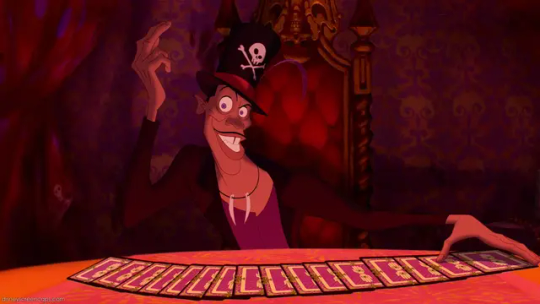
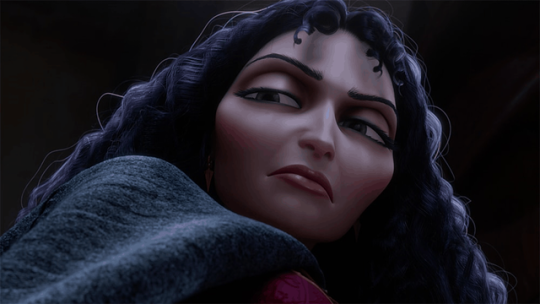
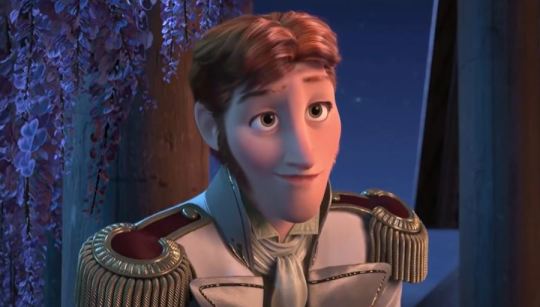
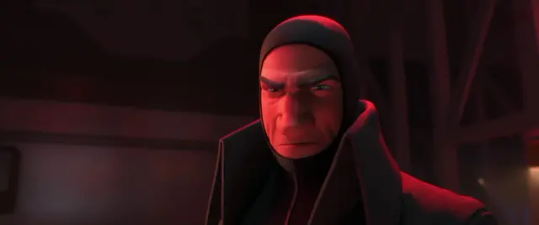
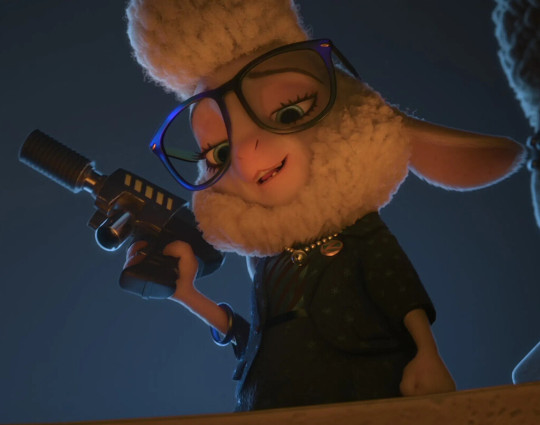



King Magnifico's failed characterization and poor writing in "Wish" really bummed me out. I was looking forward to a complex villain who was kinda right. I was hoping it could usher in a new age of Disney villains who were more grey than black and white, who made the characer grow as a person because they challenged their perspective. But then I realized that the opportunity existed in earlier revival-era villains:
Dr. Facilier is a villain first and foremost, though thinking back on it, I do think he is kinda proto-Magnifico, granting people's wishes, only for them to find that what they wanted isn't what they expected. I do wish he tied a bit of truth in with his scams, mentioning (similar to Magnifico) how people's dreams are very difficult to achieve--especially in the post-WWI American South, particularly POC. Naveen is generally assumed to be a POC himself, so he could juxtapose this viewpoint as someone who's never really had to experience such hardships. Dr. Facilier could still be 100% villainous, but further emphasis on dreams, wishes, and hard work would be part of his character. However, this is the reverse of "Wish"; Tiana has already worked hard, but she's lost a lot of her innocence and light-heartedness trying to achieve it, thus causing her to reevaluate how important love is and how she may not have realized it, being more practical about her dreams. It all starts with a wish.
Mother Gothel was already right; the world can be dark and cruel, and will destroy any light it finds. However, similar to Magnifico, since she's completely evil, the protagonist she goes against doesn't really change to understand what she's saying. Rapunzel doesn't see the world as dark or dangerous anymore; it's the opposite, thanks to her experiences. Because of this, I do wish Rapunzel did have a bit more negative experiences independent of Gothel to prove Gothel's point rather than it being "hey, she's just saying that because she's the villain." Maybe Rapunzel tries healing someone and people start lusting after her hair.
Hans is DEFINITELY a missed opportunity. He was the anti-Anna; isolated and alone, and he became bitter and cruel because of it. It's mentioned that the deleted song "More than Just the Spare" was removed because it made Anna too much like Hans. I don't think that, and if anything, it furthers my point: Hans gave up on his brothers, who he felt overlooked by and pestered by (he doesn't even mention his parents). Maybe give Hans less brothers and feature them a little in the movie so we can see how they interact with Hans and how it's a "what could be" for Anna and Elsa. His evil character is exactly what Anna is trying to avoid, but she understands how he became this way rather than it simply being for shock value.
Yokai was a great villain to me, but the reveal happened too late. I'd have loved seeing a more thorough exploration of his character and parallels to Hiro (which were done great in the film; I just wish it was expanded on). Highlight how people quickly forget about the dead and don't always learn from history, how there's this cycle of loss and hatred that you have to break.
Bellweather was on a power trip, but I do wish she had a storyline similar to Judy and Nick, since--in an interesting twist--they come off as more interesting and complex than the villain. She doesn't really say what made her act like this, and comments that "fear always works." I wish we got more of that, especially to play the two sides card; Zootopia is mainly predator-phobic, and challenges to this, ie predators playing down predator-related crimes in order to get people to look past their identity (and the fact that many predators are in positions of power) may have caused Bellweather's abuse by predators to be overlooked, causing her to want them all gone.
Te Ka is interesting. Despite "Moana" being a great film, I do feel like Te Ka and Maui's storyline was underutilized. It's revealed Maui stole Te Ka's heart for humans, but from what we see, Moana lives in this ideal community where their heritage, culture, and nature is loved and respected. Maybe embrace the fact that Tala is the only one who tells the story of the ancestors and how being they became "comfortable" since they were no longer voyagers, being used to the hierarchy and their stagnant society. Highlighting some humans' selfish natures would've been nice rather than Maui just telling us about it, with Te Ka being a metaphor for the destruction and disregard for nature and love.
Namaari is such a missed opportunity. Despite caring about her community, she comes off as more villainous than an antihero since she doesn't show any sympathy or care for Raya--in fact, she seems rather smug about hurting her. By making her a villain burdened by expectations and love for Fang while slowly being redeemed would've been better to me, shifting her POV slowly, making Raya angry with Namaari but understanding her motives. Having some regret about her choices--even if she believed they were the right ones--would've gone a long way for Namaari's characterization.
Magnifico...well, you already know he could've been one of Disney's most complex villains. Horrifying backstory and powers that are the result of hardwork left him with a jaded view on wish granting. He wants to help others, but has MANY reservations about it.
This is just my POV, of course; some of you may disagree (or feel like the aforementioned villains already achieved what I ask for), but I do hope future Disney villains have that "they're kinda right, even if they're wrong" characterization. It'd be a nice new era as the successor to traditional villains and twist villains--though just like twist villains, this trope requires VERY good writing.
#disney#disney animation#disney princess#magnifico#king magnifico#the princess and the frog#dr facilier#gothel#mother gothel#tangled#hans#frozen#yokai#big hero 6#big hero six#zootopia#moana#namaari#raya and the last dragon#disney villains
227 notes
·
View notes
Text
"Disney's princess needs to have more diverse personalities!" Yes true, sure, but also
Disney's first three Princesses (Snow White, Cinderella, Aurora) are all graceful, sweet, like singing songs about dreams and wishes, and do not actively fight: "omg they're such anti-feminist caricatures!!!"
Disney's next princesses have more established emotions and personalities, alongside the establishment of the "I Want" song as applied to motives outside of love (exploration, adventure, making their family proud): "OMG Ariel traded her voice for a man, how stupid!" "Belle's so stuck-up!" "Jasmine's just a spoiled brat!"
Tiana's a dedicated hard worker, loves her family a lot, and wants her loved ones to be very happy even at her own expense and gets... totally ignored in this conversation, gee I wonder why
Rapunzel, Anna, and now Asha are a little bit awkward, silly, but exuberant and get written off as "stupid adorkable" despite the other tenets of their personalities setting them apart, like Rapunzel's creativity, Anna's dedication to her family, and how Asha strives to help those around her
Moana gets called a disobedient brat for seeing beyond her father's narrow-mindedness
Disney Princesses have many wonderfully different personalities. It's just that people are dedicated to misinterpreting them, and that's why I never take the "Disney Princesses need more diverse personalities!" comment at face value.
#of course rapunzel's socially awkward she's been shut in a tower for eighteen years!!! she's also creative sneaky and sees good everywhere!#anna is dedicated to a sister that as far as she knows has never shown her an ounce of love in ten years even after their parents died#but oh wow! both of them make one goofy face once and suddenly they're 'adorkable oh boo disney needs better protags!'#asha is understandably nervous about meeting the literal king of her beloved country and somehow that a bad thing????#long story short i think the 'adorkable' is just the current word for 'why i don't like disney princesses for *checks notes*#being disney princesses'#disney princesses#ALL DISNEY PRINCESSES ARE WONDERFUL
168 notes
·
View notes
Text
I was talking with my dad while he was playing Legend of Zelda Tears of the Kingdom. He mentioned he was going to get Sundelions so he could use them to make anti-Gloom food for the Ganondorf fight. I wondered what exactly they were and what gave them the power to deflect Gloom, and he mentioned they came from the sun.
And that’s when it hit me. A flower? That came from the sun? Is what can beat Ganondorf?
So anyways that’s why I think Rapunzel from Disney’s Tangled could save Hyrule—

#totk#loz totk#I BELIEVE IN HER#legend of zelda#the legend of zelda#the legend of zelda tears of the kingdom#legend of zelda tears of the kingdom#tears of the kingdom#how many variations of this tag are there#Tangled#rapunzel#tangled rapunzel#disney’s tangled#I hate Disney but this is funny#the image of the king of evil being bested by this girl with long hair and no shoes#it’s too good#thanks dad
55 notes
·
View notes
Text

Actually that’s why people relate to Elsa more than rapunzel. Rapunzel is just static character who is rarely effected by her upbringing. At least with Elsa, we can see how her upbringing effected her and how that shaped her personality. Another reason why rapunzel fails as a character is that she has no flaws and everything goes right for her. Elsa, on the other hand, does have flaws and she causes the conflict in Frozen.
Don’t get me wrong, there are a lot of flaws in Elsa as a character and the movie. However, there is a reason why a lot of people love Elsa and look up to her while people struggle to remember rapunzel’s movie. Also, saying rapunzel is a better character than Elsa is laughable because rapunzel has just as much personality and character as aurora from Disney’s sleeping beauty.
It also is funny how these people just go and demonize Elsa for running away from the kingdom when that’s the point of the story! They also skipped over the reason why she ran away was because she was scared what the people at the kingdom were going to do to her. In her mind, they saw her as a monster. She also ran away because Elsa didn’t want to hurt anyone else like she hurt Anna in the past.
God, this is why we keep getting bland characters like Disney’s rapunzel! People only see shit from a black and white perspective. This includes characters who make mistakes or have flaws in a movie or show. “Oh no, this character lied! I know the story said he had low self esteem but still! He is the worst character ever!” If these people want to watch movies and shows with bland ass characters, they should watch blues clues or some shit.
(I just stumbled upon yet another video on why Elsa is a bad character and went into the comments. Can they pick another topic?)
24 notes
·
View notes
Text
I didn't even watch "WISH" yet because in my country it will only be available at january, but people are saying it's a bad cliche so I probably won't watch at the cinema.
The thing is, even though I am a hopeless romantic, not everything has to have romance. There are princess who are perfectly fine without a prince, like Mirabel, Elsa, Merida, Moana and Raya(I do kinda like the idea of Raya with a girl, just not Namaari). But we were so robbed of seeing Asha and the star boy(he is literally a staR so I don't doubt Disney would call him StaN or something like that, so his name is Stan from now on, I am gonna call him like that, is easier than star boy). Asha and Stan had the potential to be the next Tianaveen and Rapunzel&Eugene (I don't know their ship name). The concept arts are the cutest thing I have ever seen. Also "At All Costs" (bop) would have been a love song between the two!!! Them singing it man. The pain I will feel when I don't see them passionately sing it, very "I see the light" coded, in the actual movie. Somehow, now is not feminist for a strong female character to have a male partner by her side. Like...This doesn't make sense! You can be a strong female character and have a man at the same time! Have y'all forgotten Mulan and Shang? Anna and Kristoff? Ariel and Eric? Jasmine and Aladdin? (There are more examples and I could go on all day, but you got what I meant already) I hate Disney for throwing good ideas at the trash and playing safe just for money(like Hobie Brown/Spider-Punk said "it's a metaphor for capitalism"). And as the guy looked blonde with blue/green eyes in the arts I have seen, and Asha is a black latina, they lost the opportunity of having a biracial couple ACTUALLY DONE RIGHT (Pocahontas and John Smith don't count, he is a collonizer with the most common name in the world, she deserves so much better). Like, if the thing is show how inclusive you are by having a black latina female protagonist for little girls to see and feel represented in a good way, you could have increased that feeling by making someone fall in love for her. Little girls would feel like they are beautiful and desired/desireable in a positive way and that they worthy of being loved and love and be with whoever they want to be with, even someone who has a different skin color.
I am also mad because we could have seen Disney's first evil villain COUPLE with King Magnifico and his wife, the queen(still don't know her name, sorry). Can't you guys imagine the HITS, THE FIRST PLACE OF BILLBOARD HOT 100 WORTHY songs, they would proportionate us? Even if only one song, it would be enough for me. But someone thought having a female villain would be anti-feminist and they discarded an original and authentic idea, which is what Disney built its empire on the first place. Come on Disney minorities don't want to be portrayed as those unrealistic superior beings, they want to be portrayed as real human beings with emotions, struggles, qualities and flaws. Having an iconic female villain like you guys always had(like Maleficent, Cruella De Vil, Ursula, Mother Gothel, Lady Tremaine, etc) and set her up with an iconic male villain(like Gaston, Doctor Facilier, Shan Yu, Jafar, Hans, etc) it would have been top notch, god tier. King Magnifico and the queen could have been like the Gomez and Morticia of evil. You could address so many topics by it. Like the kingdom being ruled by evil would have been a great social critic of some politicians out there, for example. And we could have had an iconic final boss battle between Asha and Stan VS Magnifico and the queen.
Anyway, what I mean by this is that if someone has fanarts or just ANY CONTENT, of Asha and Stan, tag me, reblog this or comment, I don't care, just warn me, because they are my new obsession. I will also write a fanfic about this movie with these ideas, but only after I have watched the movie so until them, please feed my hyperfixation in Stasha (Star boy/Stan×Asha), I'm begging y'all
#disney wish#wish 2023#princess asha#wish asha#king magnifico#asha x star#asha x star boy#asha x stan#asha x star guy
55 notes
·
View notes
Text
More than "Sheer Coincidence": The Antisemitism of Disney's Animated Villains
This is a paper I wrote for a Jewish studies class. It was inspired by a tumblr post, so I thought it was fitting to share here. Most will be under a "read more" link, as it is about 25 pages including the bibliography. Please feel free to ask questions, and enjoy.
_______
On June 19, 2022, Tumblr user fantastic-nonsense published a post about Disney’s 2010 animated film Tangled, and the film’s villain, Mother Gothel, which starts, “*sigh* the ‘Mother Gothel is an anti-semitic caricature’ discourse is going around again.” They argue that, because Mother Gothel’s appearance was based on two non-Jewish women, Gothel’s voice actress Donna Murphy and singer Cher, any claim that Mother Gothel’s large nose or dark, curly hair resemble antisemitic caricatures was simply projection. The goal of Gothel’s design was to make her as visually distinct as possible from Rapunzel, not to make her “look Jewish.” They continue with a question:
“[I]f Gothel was blonde with a ‘normal’ nose…but literally nothing else about her changed, would you be saying that she’s an anti-semitic stereotype?...All I’m saying is that Gothel (and thus Tangled) is unreasonably linked to those tropes…There is a very distinct difference between being actively anti-semitic and Tangled, which has anti-semitism being projected on it because its villain bears passing similarity to anti-semitic caricatures out of sheer coincidence.”
The user has since deleted the original post, but a reblog remains further arguing their point. In an attempt to defend the film from criticisms of antisemitism, fantastic-nonsense stumbles upon a fundamental conundrum of analyzing villainous characters such as Mother Gothel: Is it possible to create a villainous character that avoids all potential antisemitic pitfalls? And, despite fantastic-nonsense insisting it’s a “sheer coincidence,” why do so many Disney villains have stereotypically Jewish traits?
Unmasking Antisemitism: The Origins of Disney’s Jewish Villains
Jewish people have long been viewed as villainous in various gentile European cultures, a view brought to the United States through colonization. Accusations of blood libel go back to the 12th century and have been noted from eastern Europe to England. Famous authors and playwrights such as Charles Dickens and William Shakespeare indicate a centuries-long trend of villainous characters defined by their Jewishness, and infamous business magnate Henry Ford published accusations of predatory banking practices and fervent Christian hatred in his pamphlet series The International Jew in the early 1920s, before Disney was a studio. With centuries of association between Jews and villainy as a backdrop, there is little surprise that Disney turned to antisemitic tropes in the construction of one of its earliest villains.
The 1933 short Three Little Pigs is remembered as one of the most successful shorts from Disney’s Silly Symphonies series. Not only was the film the source of the song “Who’s Afraid of the Big Bad Wolf?” which became an anthem to “Depression-weary audiences,” but the film was a milestone in character development, versus the characters existing only to serve gags. Walt Disney was so proud of the finished film, he said, “At last we have achieved true personality in a whole picture.” Part of developing the characters’ personalities was creating a menacing villain, an archetype Disney would come to be known for, and the Big Bad Wolf is one of its earliest successes on this front. The film follows the typical narrative of the fairy tale, with a trio of pigs each building their own house, one of straw, one of sticks, and one of brick. We see the Wolf approach them as the first two are frolicking after constructing their flimsy houses, drool pouring from his mouth filled with sharp teeth. While the Wolf is able to simply blow away the straw house, the house of sticks proves to be a bit stronger, and he resorts to trickery, pretending to give up and leave the pigs alone before returning dressed as a sheep and asking for shelter. The pigs sees through this disguise, refuse him entry, and his anger gives him the strength to blow down the house of sticks. When the pigs flee to the house of bricks, the Wolf returns with a new disguise: a Jewish peddler.
Wearing a large brown overcoat, green-tinted glasses and a skullcap, and adorned with a fake beard and long nose, the Wolf knocks on the door of the brick house with a rack of brushes around his neck, proclaiming in a Yiddish accent, “I’m the Fuller Brush man, I’m giving a free sample!” The pig from the brick house, quickly seeing through his tricks, proceeds to hit him with said free sample before pulling a welcome mat from beneath the Wolf’s feet, causing him to land on his face and his false nose to bend 90° towards the sky. The Wolf rips off the disguise in anger, and the short continues.
The association of Jews and the peddling profession arose during the 19th century, as peddling helped facilitate the mass migration of Jews across the globe during that time. Peddling was more accessible to poor immigrant Jews than owning a store, and the freedom of self-employment allowed them to maintain their own schedule and keep Shabbat, unlike factory jobs. As most peddlers did not maintain the job for more than a decade, nor pass it down to their sons, peddlers represented a lack of assimilation, perpetually tying the occupation to otherness, which facilitates the villainization of peddlers through their Jewishness.
The stock character of the “Jew peddler” quickly entered popular culture, giving all manner of creatives, from commentators to novelists, a new punching bag in their library of cultural symbols. As Hasia Diner describes the figure in her book Roads Taken: The Great Jewish Migrations to the New World and the Peddlers Who Forged the Way, “Sinister and shadowy, exotic or absurd, he made a good subject for mockery, with his odd accent, his clothing, his lack of a fixed abode, and his distinctive bodily features: in this milieu, a prominent hooked nose was a sure sign of Jewishness, a long beard a likely trait as well.”
Director Burt Gillett created a costume for the Disney short’s villain which ticked off every box in the “Jew peddler” playbook. A symbol of “trickery, otherness, and greed,” and pervasively believed to be dishonest, the peddler costume serves not only as a disguise for the Wolf, but to highlight those traits in his villainous hunt of the pigs. Audiences would have had a pre-existing cultural understanding of the Jewish peddler as a costume. Throughout the 19th and into the early parts of the 20th century in the United States, local newspapers reporting on masquerade parties described “Jew peddler” costumes among princesses and pirates. With his two costumes being a play on the phrase “a wolf in sheep’s clothing” and the known manipulative figure of the Jewish peddler, the characterization of the Wolf is clear: He is so manipulative, even his choice in costumes shows off his deviousness.
There is a more intelligent side to the gag of the Jewish peddler costume; not only would the Wolf seem less threatening dressed as a Jewish peddler, but the pigs would assume he kept kosher and didn’t eat pork, easing their worries. Still, the use of antisemitic stereotypes to emphasize the Wolf’s dangerous and manipulative nature has been recognized as offensive, including by the company itself. A 1948 re-release of the short edited the animation to remove the antisemitic costume. The Wolf still dresses as a peddler, but without any Jewish signifiers, maintaining the overcoat but swapping the skullcap and green-tinted glasses for a bowler hat and clear ones, and forgoing the nose and beard altogether. Initially, the original audio was maintained, as the new animation of the wolf still matches the original dialogue, but a new version of the Wolf’s audio was recorded and replaced the Yiddish accent at a later date. Instead of hawking his wares in a Yiddish accent, the Wolf puts on a low, unintelligent-sounding voice and tells the pigs, “I’m working my way through college!” This is the version of the short that is available on Disney+, where no mention is made of the short’s history or the edits that were made to it. Although the Wolf does not have the same notoriety as many of Disney’s villains from feature-length films, he didn’t fall into complete obscurity, making a cameo in Who Framed Roger Rabbit (1988) alongside the pigs, and appearing in the 2002 direct-to-video film Mickey’s House of Villains. 90 years after his first appearance, the Wolf’s legacy resonates in the designs and characterization, which Walt so highly praised, of the villains who came after him.
Hooked-Nosed Hags and Mincing Manipulators: Jewish-coding in 20th Century Disney Films
Disney took its first leap into feature-length animation in 1937 with Snow White and the Seven Dwarfs. Released only four years after Three Little Pigs, the film displayed a marked improvement in many areas of animation, particularly character design. While previous Disney shorts had largely starred animals, Snow White featured an entirely human or human-like cast. Unable to differentiate between hero and villain by species, designers needed other visual signifiers to indicate a character’s villainy or heroism to the audience. As former Disney character animator Andreas Deja wrote on his blog, where he frequently catalogs stories from Disney’s older films, “[Walt] Disney insisted on strong contrast between good versus evil, and that needed to be clear in the characters' design as well as their acting.”
In 1749, German philosopher and playwright Gotthold Ephraim Lessing wrote in his play Die Juden (The Jews), “And is it not true, their countenance has something that prejudices one against them? It seems to me as if one could read in their eyes their maliciousness, unscrupulousness, selfishness of character, their deceit and perjury.” For centuries, antisemites have posited that Jews not only are evil, but look evil based on their natural physical appearances. This idea quickly made its way into Disney’s understanding of character design. Although Three Little Pigs’ Wolf is the only villain who takes on an explicitly Jewish appearance, Disney has designed its villains with stereotypically Jewish traits as a visual indicator since its first feature film. This notion of visual signifiers of internal traits is derived from race science, a concept the American government had latched onto with the Dillingham Commission, a Congressional committee analyzing immigration in the United States at the end of the 19th and beginning of the 20th century. In the Commission’s Statistical Review of Immigration, published in 1911, the “Hebrew” people were the third-lowest ranked group in the “Caucasian race.” As Jews were considered one of the least desirable groups of white people, common traits amongst them were quickly associated with villains, regardless of their background.
Snow White’s Queen Grimhilde does not have many stereotypically Jewish traits upon first glance. This is essential to the story, as the Queen was previously the “fairest one of all” until her title was taken by Snow White, whose beauty outshone hers even while dressed in rags. Because she is also beautiful, she could not be designed with ugly, villainous, “Jewish” traits. However, when she finds out the Huntsman failed to kill Snow White, she adopts a disguise in order to poison her without being recognized, much like the Wolf in The Three Little Pigs. Her disguise transforms her from a beautiful, regal woman into a decrepit witch, with a massive, hooked nose and deep eye bags, both common traits in antisemitic caricatures, marking her new form as Jewish. Her transformation marks her change into a more active villain role, pursuing Snow White herself instead of sending a henchman to find her. By the end of the film, the Queen’s internal ugliness, through her vanity and envy of Snow White, has physically manifested, showing that she was never really as beautiful as the kind-hearted and button-nosed Snow White.
The contrast between the Aryan features of Disney’s leading ladies and the ugly and Jewish-coded traits of their female villains continued for decades. Cinderella’s stepmother, Lady Tremaine, and her daughters are both drawn with large noses compared to Cinderella, who has a button nose similar to Snow White. Lady Tremaine is given a hooked nose and heavy-lidded eyes, just as Queen Grimhilde had in her disguise. Her less exaggerated appearance befits her more realistic villainy, portraying personal greed and child abuse rather than a magically enhanced poisoning plot. The stepsisters, on the other hand, are given bulbous noses, similarly to Snow White’s seven dwarves, largely indicating ugliness rather than Jewishness. In both cases, their designs are “more reminiscent of 101 Dalmatians male villains Horace and Jasper, rather than typical Disney female features.” All three are given features reminiscent of Disney’s male character designs, compared to Cinderella’s “proper” femininity, which, at this point in Disney’s history, was always white.
Maleficent and Aurora’s designs in Sleeping Beauty function similarly. Maleficent’s pointed nose, prominent horns, which Jews are often accused of having, and green skin make her appear inhuman compared to Aurora’s upturned nose and blonde hair. Maleficent’s appearance is also juxtaposed against the film’s good fairies, Flora, Fauna, and Merryweather, who look entirely human aside from their wings. Sleeping Beauty also furthers the concept of appearance reflecting personality, giving the cruel Maleficent an unnatural skin tone, and displaying her most powerful form, a dragon, at the climax of the film. It is important to note that both Maleficent and Queen Grimhilde use magic and potions in their villainy, while their respective princesses do not use magic on their own. Judaism and witchcraft have long been associated in European Christian concepts of witches, and these films both bring that trope into a new world of storytelling.
While Disney’s early female villains were largely coded as Jewish by their designs and the juxtaposition between them and Disney’s respective female lead’s designs meeting Euro-centric standards of beauty, male villains’ coding comes at the nexus of homosexual and Jewish male stereotypes, alongside their designs. In her description of the coverage of Leopold and Loeb’s 1924 murder trial, Sarah Imhoff wrote that “the press coverage did not often explicitly cite their Jewishness because it did not need to. Journalists and commentators were able to convey Jewishness without stating it directly. Certain characteristics—intellectual, physically weak, not fit for manual labor, perverted, and prone to illness and psychiatric imbalance—painted a gendered portrait of a Jewish man even without reference to race or religion.” Many of Disney’s male villains fit such descriptors, indicating their Jewishness to the audience without the religion ever being mentioned. Additionally, these descriptors–particularly “perverted,” which at the time was a euphemism for both religious and sexual deviance-- are often applied to gay men, while homosexuality was treated as its own psychological issue. Both queer and Jewish men are seen as feminine, not meeting the white Christian ideal of a strong, straight, and stable man. With such overlap, queercoding of male characters often coincides, intentionally or not, with Jewish-coding.
The effeminate, mentally unstable villain can be found as early as the 1950s with Peter Pan’s Captain Hook, a willowy man in a plumed hat prone to comedically anxious outbursts, with black, wavy hair and a large nose. Captain Hook is voiced with a British accent, as many of Disney’s male villains do (including Jafar, Scar, and Governor Ratcliffe, whose fitting British accent stands out against John Smith’s strangely American one), which is not typical of Jewish characters in American media. However, “unlike the good characters of the film, who are endowed with physical features more generally identified with Northern European characters, the Captain Hook character would appear to be more Southern or Eastern European…he is the villain, and the writers and artists chose to give him physical characteristics that somehow reflect his villainy.” The author does not mention Jews in his analysis, but the majority of American Jews are descended from Eastern European Jews, and the comparison is bolstered by the non-visible Jewish stereotypes Hook fits as well. Again, Hook’s features are contrasted against Peter Pan and Wendy’s straight, brown hair and upturned noses, matching his implicitly Jewish characteristics with an implicitly Jewish appearance.
The Disney Renaissance, a period from 1989-1999 which saw massive success for Disney and a notable Broadway influence on the films, also saw a barrage of male villains with notable Jewish-coded traits. While Aladdin’s Princess Jasmine has a slightly larger nose compared to her white princess predecessors, Jafar still has much more prominent and hooked nose and heavy-lidded eyes, traits even more prominent in early iterations of his design. Jafar fits many of the descriptors applied to Leopold and Loeb in lieu of calling them Jewish; he is a manipulative magician with a wiry frame, contrasted by Aladdin’s larger build and ability to run and swing around Agrabah to avoid guards, and becomes mad with power after wishing to become a genie himself. Appearance-wise, in addition to the Jewish-coded traits mentioned above, Jafar’s dress-like robe and elaborate headpiece give him a feminine appearance next to Aladdin’s pants and vest, and bare muscular chest, affirming his masculinity. Imhoff notes that, because of Jews’ intelligence and lack of physical prowess, the prevailing stereotype was that “Jews tended not to commit courageous crimes, but rather chose crimes where they did not have to confront their victims directly.” She extrapolates, “Jewish men’s crimes were crimes of intellect, not passion; manipulation, not aggression; outsmarting, not overpowering.” Jafar displays these methods of criminality multiple times, tricking Aladdin into fetching the genie’s lamp from the Cave of Wonders, lying to Jasmine about Aladdin being sentenced to death, and hypnotizing the Sultan with his staff to steal an heirloom jewel. Although Aladdin uses his wits to defeat Jafar by trapping him in the magic lamp, his physical strength both make him more attractive and capable in Jasmine’s eyes than Jafar, who pursues her for political gain.
The Lion King’s Scar is a more prominent example of the juxtaposition between the strong but simple hero and the weak but wily villain. After feminizing himself, proclaiming “I shall practice my curtsy,” when his brother King Mufasa tells him that Simba, Mufasa’s son, will one day be Scar’s king, Scar says, “Well, as far as brains go, I got the lion’s share. But when it comes to brute strength, I’m afraid I’m at the shallow end of the gene pool.” While the heroic Mufasa, and later Simba, are muscular and broad, Scar is drawn almost emaciated, his hips swinging with each step in an effeminate manner. Like Jafar, Scar rarely involves himself directly in his crimes, sending his hyena henchmen to do his dirty work while he devises a plan. While animated lions lack the physical traits associated with Jews, Scar’s strangely dark mane contrasts with Mufasa and Simba’s reddish fur, and the dark circles of fur around his eyes resemble both heavy eyelids and eyeshadow, serving as both a feminizing and Jewish trait. When Scar and Simba fight at the climax of the film, Scar resorts to gaslighting, trying to convince Simba that he is responsible for his father’s death, and tricks, throwing burning ashes into Simba’s face, rather than beating him with brute strength.
Pocahontas’ Governor Ratcliffe fits oddly into the field of simultaneously feminized and Jewish-coded villains. His purple outfit, braided hair, and posh mannerisms make him by far one of Disney’s most effeminate villains, and he is one of the most explicitly money-hungry villains in Disney’s film library, singing lyrics such as “It's mine, mine, mine/For the taking/It's mine, boys/Mine me that gold!” blatantly assigning Ratcliffe the stereotype of the greedy Jew. Yet the historical setting of the film, 17th century Virginia, makes it highly unlikely that Ratcliffe could possibly be Jewish. Still, his overwhelming greed and feminine mannerisms insert Jewish stereotypes into even the most unlikely settings, highlighting the pervasiveness of the stereotypes beyond direct acknowledgements of Judaism.
Although Hercules’ Hades is less feminized than his 90s predecessors, his coding is bolstered by frequent use of Yiddish words in his dialogue, describing Hercules as “the one schlemiel who can louse” up his plan, calling him “The yutz with the horse!” when directing the titans to attack him, and convincing Hercules to fall for his scheme by telling him, “We dance, we kiss, we schmooze, we carry on, we go home happy.” Portrayed as a fast-talking swindler, calling back to the fear of peddlers Disney utilized in Three Little Pigs, Hades follows the trend of having a hooked nose and deep-set eyes, as well as being significantly weaker than Hercules, who is characterized throughout the film by his immense strength and lack of forethought. While Hades nearly succeeds in getting Hercules to kill himself by diving into the River Styx to save Megara, once Hercules achieves godhood and becomes immortal, all it takes is a single punch to knock Hades himself into the river and defeat him.
Both Hades and Jafar also play upon fears of not just homosexuality but sexually deviant heterosexuality in their respective films. While Jewish men were characterized as feminine due to circumcision in the late 19th century, “Jews were not thought to endanger society by their supposed homosexuality but rather by their evil heterosexual drives. […] But while family life was intact among the Jews themselves, it was, so racists asserted, directed against the family life of others.’” While neither Jafar nor Hades express genuine attraction toward their female leads, each interferes with their predestined heterosexual relationship with the male lead. When Jafar fails to retrieve the lamp from Aladdin before he uses it, foiling his plan to become Sultan, his parrot henchman Iago suggests that Jafar marry Jasmine as a means of becoming Sultan instead. Jafar proceeds to brainwash the Sultan into pronouncing him Jasmine’s fiance while she builds a relationship with Aladdin, and nearly succeeds in forcing her to marry him, before Aladdin interrupts his plan. Hades gained leverage over Megara after she made a deal with him for a man who left her, and has her woo Hercules only to sacrifice her, using Hercules’ emotions to manipulate him into nearly killing himself trying to save Megara. In both cases, genuine heterosexuality triumphs over “evil heterosexual drives.” Even with Aladdin’s Arabian-inspired setting and multiple mentions of Allah by the Sultan, conceptions of pure heterosexual love shaped by Christian values save the heroines from deviant, and implicitly Jewish, heterosexuality.
Across decades, genders, and settings, Disney has not only continued to rely on antisemitic stereotypes to communicate villainy through character design, but has developed its villains to incorporate increasingly specific stereotypes that have been applied to Jews for decades, if not centuries.
(Not Her) Mother Knows Best: Mother Gothel and the Blood Libel of Tangled
The 2000s was a time of experimentation for Disney Animation. As the success of the Renaissance began to fade, Disney turned to genres and technologies it hadn’t worked with before. The early 2000s saw an onslaught of films with unprecedented science fiction elements, such as Atlantis: The Lost Empire, Treasure Planet, Lilo and Stitch and Meet the Robinsons. Beginning with Dinosaur in 2000, Disney slowly made its way into the field of CGI animation, developing its technology at a rapid pace across films like Chicken Little, Bolt, and the aforementioned Meet the Robinsons. After this decade of experimentation, Disney released a film which combined the musical and princess elements of the Renaissance with the CGI it had been developing, releasing its first CGI princess film: Tangled. A reimagining of the fairytale of Rapunzel, the film has been a topic of discussion since its release for both its villain, Mother Gothel, who embodies a wide variety of traits, both in her design and characterization, that have been negatively associated with Jews; and its story, which bears striking similarity to a long-standing antisemitic canard: blood libel.
Beginning with accusations of using blood in religious rituals in the 12th century, in the 13th century, an additional accusation further vilify Jews: “Jews killed Christian children to obtain their blood, turning ‘ritual murder’ into ‘blood libel’ or ‘ritual cannibalism.’” Jews were not only accused of killing Christian children, but using their bodies for personal gain. Although Tangled forgoes any child killing, its prologue tells a chillingly familiar tale of the kidnapping and exploitation of a beautiful, blonde infant by a dark and curly-haired, crooked-nosed woman, adapting the blood libel narrative for a new audience, just as blood libel narratives have adapted to fit “changing cultural and political climates.”
In developing a story fit for a feature-length movie, Tangled adds magical elements to its narrative absent from the original fairy tale. In the film, a drop of sunlight fell to earth in the form of a flower with incredible healing capabilities. This flower is discovered by Mother Gothel, whom the audience meets as an old woman, who discovers a song which, when sung to the flower, makes her young. Her young appearance incorporates many of the antisemitic archetypes present in previous villains including long, black, curly hair, dark, hooded eyes, and a pointed nose with a bump. Gothel hides the flower to hoard its powers for herself, immediately establishing her as greedy, another common antisemitic trope. When the pregnant queen falls ill, the search party is sent for the mythical flower, hoping it will heal her. It is found, and after drinking a medicine made from it, the queen recovers and gives birth to a healthy girl, Rapunzel, with hair that is inexplicably bright blonde, as both the queen and king have brown hair. Aging and growing desperate, Gothel sneaks into the castle and cuts a lock of Rapunzel’s hair, only to discover that the hair, which has gained the flower’s magic, loses that magic when cut. She decides to kidnap Rapunzel, hiding her away and raising her as her own to continue utilizing the hair’s magic properties.
Many Disney films have utilized the contrast between villains’ and heroes’ character designs to indicate to the audience which role they play, with villains getting Jewish-coded features and heroes largely getting Western European ones. In nearly every way, Rapunzel and Gothel’s designs are completely opposites. Gothel’s frizzy dark hair could never be related to Rapunzel’s blonde, straight, silky mane. Gothel’s eyes are dark and hooded where Rapunzel’s are green and wide. Gothel’s nose is bumpy and hooked where Rapunzel’s is small and turns up. Gothel is curvaceous where Rapunzel is petite. In every way that Rapunzel fits the Aryan ideal, Gothel sits firmly in the category of other, even if both are white. Gothel’s foreign appearance was very intentional by the film’s director. In an interview, co-director Byron Howard said, “So, Gothel is very tall and curvy, she’s very voluptuous, she’s got this very exotic look to her. Even down to that curly hair, we’re trying to say visually that this is not this girl’s mother.” This goal in character design was repeated by him and co-director Nathan Greno in various interviews.
More than simply creating visual difference between Rapunzel and Mother Gothel, Gothel’s “voluptuous,” “exotic look” plays into the classic trope of the “Beautiful Jewess,” an orientalized beauty who tricks others with her alluring appearance, “‘her beauty conceal[ing] her powers of destruction.’” Gothel gaslights Rapunzel to keep her in her tower, convincing her that her naivete makes the outside world too dangerous for her to live in, and the contrast between Gothel’s curvy and sexualized body and Rapunzel’s petite frame only serves to bolster her claims. It is notable that early iterations of Gothel’s design show her without many of the visually “Jewish” traits she has in her final designs, with straighter hair tied back in a low bun, rather than the large curly hair seen in the film. Several designs have long, but not hooked, noses, and higher collars, avoiding the “Jewish seductress” aspect of her design. Yet these designs were rejected in favor of one influenced by two famous women: Donna Murphy, who voiced Mother Gothel, and Cher. Cher in particular was looked to for being “very exotic and Gothic looking,” playing into the orientalization of the Beautiful Jewess, where “the physical beauty and sensuality of the Jewish woman, her dark hair…were almost always described using orientalizing tropes and characteristics.” Although neither Cher nor Murphy is Jewish, both have the dark, curly hair and large noses associated with Jews, and the choice to base Gothel’s appearance off of them, particularly Cher’s “exotic” beauty, plays directly into pre-existing antisemitic tropes, whether intentionally or not.
Like Queen Grimhilde and Jafar before her, Gothel utilizes a disguise as part of her villainy. However, Gothel’s disguise, her false youth, is constant throughout the film, rather than temporary for one evil act. The Beautiful Jewesses’ “imaginary proximity to seduction, sexuality, theater, and dance, as well as to masquerade and costumes, certainly had just as much to do with their femininity—situated outside of bourgeois gender roles—as with their Jewishness.” Both Gothel’s Jewish features and her sexualized femininity play a role in the manipulative nature of her youthful disguise.
Not only do the narrative similarities to blood libel and the design of Mother Gothel play into antisemitic tropes, but more so than previous evil mother figures in Disney films, Gothel fits the “stereotype of the overbearing, over-involved, suffocating Jewish mother.” While Queen Grimhilde and Lady Tremaine force Snow White and Cinderella, respectively, into servanthood, Gothel pretends to care for Rapunzel, as exemplified in the song “Mother Knows Best.” In addition to warning Rapunzel of the dangers of the world outside her tower, she guilts her for wanting to leave her, singing “Me, I'm just your mother, what do I know?/I only bathed and changed and nursed you/Go ahead and leave me, I deserve it/Let me die alone here, be my guest.” Her overbearing and manipulative parenting strategies were a key part of her character, and of Rapunzel’s, according to Howard and Greno. In an interview with Den of Geek, Greno said, “If it’s a story about a girl who’s stuck in a tower, and we wanted Rapunzel to be a smart character, she’s being manipulated. So, if Mother Gothel was a mean villainess…you’d be like, Why is Rapunzel staying in the tower? You needed to buy that this girl would be there for 18 years. Mother Gothel can’t be mean. She has to be very passive-aggressive,” and Howard added, “Gothel has to be more subtle…than a one-note, domineering mother.” By playing on the loving but overbearing Jewish mother trope, Tangled establishes Gothel as a convincingly threatening and manipulative villain. The movie’s narrative tropes, character designs, and character personalities that play upon antisemitic tropes, make it difficult to deny the antisemitism present in Tangled.
The Twist Villain; Or, How Every Villain is a Little Bit Jewish
In the 13 years since Tangled’s release, many of the antisemitic tropes that had become staples of Disney’s villainous characters have been absent from its films. This coincides with a trend often referred to as the “twist villain,” where the film presents a fake villain to the audience, only to reveal that a “good” character was secretly the villain the whole time. Villains like King Candy from Wreck-It Ralph, Hans from Frozen, Robert Callahan from Big Hero 6, and Mayor Bellwether from Zootopia all fall under this trope. Because these characters are not meant to be read by the audience as evil based on their design, they lack the Jewish-coded traits like dark, curly hair, hooked noses, and deep-set eyes that have been used to mark villains as evil in the past. Other films, in lieu of a proper villain, opt for a hero’s internal conflict or a non-malicious antagonistic force to drive the story, such as Moana, Frozen II, and Encanto. These new story structures seem to eliminate the antisemitism present in other Disney films. Yet the trend of villains hiding in plain sight, lulling even the audience into a false sense of security before revealing their true colors, also plays into centuries-old antisemitic tropes.
In 19th century German criminal justice literature, “the ‘Jewish crook’ (jüdischer Gauner), a code term for a type of criminal that could apply to non-Jews as well,” was defined by “dangerous criminality masked by an assumed identity—a falsely benign exterior.” Because Disney has created an association between stereotypically Jewish traits and villainy for decades, priming audiences to read such traits as evil, by creating villains who hide their true character from both audiences and other characters, both through their actions and their non-Jewish-coded appearances, the films which use a “twist villain” both reaffirm the visual villainy of such traits and play upon another antisemitic trope.
In many ways, it seems impossible for Disney to create a villain that avoids some antisemitic trope, if avoiding stereotypically Jewish character designs only leads to affirmation of another trope. Unfortunately, it may very well be impossible. As John Appel notes in Jews in American Caricature: 1820–1914, “Jews, too, have been described as penny-pinching misers, cheats and ostentatious consumers, pushy parvenus and clannish separatists, radical unbelievers and Orthodox fanatics, ‘red’ Communists and arch-capitalists, draft evading slackers and cowardly soldiers and, more recently, bloodthirsty Israeli militarist occupiers of peaceful villages.” Whether a villain is stingy or greedy, cowardly or bloodthirsty, oddly insular or the mastermind controlling everything, they fall into a Jewish stereotype. Especially when the concept of Jews being sneaky or able to trick others comes into play, it is nearly impossible to create a villain who doesn’t hit one stereotype or another. Certainly, designs and narrative beats like the ones in Tangled make the Jewish-coding of villains far more obvious, but history’s view of Jews has permanently branded them as villainous.
That doesn’t mean that every villain is equal. Hans’ duplicity in Frozen does not raise as many alarms as the multi-layered antisemitism in Tangled. Nor does it mean that every Disney film, let alone every piece of fiction influenced by centuries of antisemitism, should be disregarded. But understanding how antisemitism has influenced Disney’s villains, and, by virtue of its films’ success and cultural dominance, impacted how the American public perceives Jews because of these portrayals, these trends can be acknowledged and criticized, instead of being willfully ignored by insisting that 90 years of cinematic history is simply a “sheer coincidence.”
Bibliography
Aladdin. Walt Disney Pictures, 1992.
“Antisemitic Caricature of a Dreyfus Supporter - Collections Search - United States Holocaust Memorial Museum.” Accessed May 6, 2023. https://collections.ushmm.org/search/catalog/irn545107.
Appel, John J. “Jews in American Caricature: 1820–1914.” American Jewish History 71, no. 1 (1981): 103–33.
Brew, Simon. “Byron Howard & Nathan Greno Interview: Tangled, Disney, Animation and Directing Disney Royalty.” Den of Geek, January 28, 2011. https://www.denofgeek.com/movies/byron-howard-nathan-greno-interview-tangled-disney-animation-and-directing-disney-royalty/.
Brunotte, Ulrike. “‘All Jews Are Womanly, but No Women Are Jews.’: The Femininity Game of Deception: Femme Fatale Orientale, and Belle Juive.” In The Femininity Puzzle, 1st ed., 21–54. Gender, Orientalism and the »Jewish Other«. transcript Verlag, 2022. https://www.jstor.org/stable/j.ctv371bzpp.4.
Carnevale, Rob. “IndieLondon: Tangled – Nathan Greno and Byron Howard Interview - Your London Reviews.” Accessed April 11, 2023. https://web.archive.org/web/20151128043916/http://www.indielondon.co.uk/Film-Review/tangled-nathan-greno-and-byron-howard-interview.
Climenhaga, Lily. “Imagining the Witch: A Comparison between Fifteenth-Century Witches within Medieval Christian Thought and the Persecution of Jews and Heretics in the Middle Ages.” Constellations 3, no. 2 (May 9, 2012). https://doi.org/10.29173/cons17200.
Croxton, Frederick. “Statistical Review of Immigration, 1820-1910.” Immigration to the United States, 1789-1930 - CURIOSity Digital Collections, 1911. https://curiosity.lib.harvard.edu/immigration-to-the-united-states-1789-1930/catalog/39-990067954980203941.
D23. “Three Little Pigs (Film).” Accessed May 1, 2023. https://d23.com/a-to-z/three-little-pigs-film/.
Deja, Andreas. “Deja View: The Evolution of Jafar.” Deja View (blog), November 30, 2012. https://andreasdeja.blogspot.com/2012/11/the-evolution-of-jafar.html.
———. “Deja View: The Huntsman.” Deja View (blog), February 3, 2015. https://andreasdeja.blogspot.com/2015/02/the-huntsman.html.
———. “Deja View: The Stepmother.” Deja View (blog), October 1, 2012. https://andreasdeja.blogspot.com/2012/10/the-stepmother.html.
———. “Deja View: Twenty Years Ago...” Deja View (blog), March 30, 2013. https://andreasdeja.blogspot.com/2013/03/twenty-years-ago.html.
Desowitz, Bill. “Nathan Greno & Byron Howard Talk ‘Tangled.’” Animation World Network. Accessed April 11, 2023. https://www.awn.com/animationworld/nathan-greno-byron-howard-talk-tangled.
Diner, Hasia. Roads Taken: The Great Jewish Migrations to the New World and the Peddlers Who Forged the Way. Yale University Press, 2015. https://web-p-ebscohost-com.remote.slc.edu/ehost/ebookviewer/ebook/bmxlYmtfXzkzMzA5Ml9fQU41?sid=c8d1f3df-2c0a-4e45-bb29-d0a83e2c8fbb@redis&vid=0&lpid=lp_13&format=EB.
“Disney+ | Video Player.” Accessed February 22, 2023. https://www.disneyplus.com/video/ddc23c92-f7d2-481c-9d71-1332af3a8c4f.
Disney Censorship: Three Little Pigs 1933 Original vs 1948 Reanimated Scene, 2022. https://www.youtube.com/watch?v=BB1mMNvrUrM.
“Disney Does Diversity: The Social Context of Racial-Ethnic Imagery.” In Cultural Diversity and the U.S. Media. Albany : State University of New York Press, 1998. http://archive.org/details/culturaldiversit0000unse_o7p9.
Englund, Steven. “The Blood Libel.” Commonweal 150, no. 2 (February 2023): 34–38.
fantastic-nonsense. “Memories of Another World.” Tumblr. Tumblr (blog). Accessed April 27, 2023. https://fantastic-nonsense.tumblr.com/post/687550407752466432/perfectlynormalhumanbeing-as-a-jew-one-of-the.
Ford, Henry. “The International Jew: The World’s Foremost Problem,” June 12, 1920. Wikisource.
Goldberg, Ann. Sex, Religion, and the Making of Modern Madness : The Eberbach Asylum and German Society, 1815-1849. 1 online resource (x, 236 pages) : illustrations, map vols. New York: Oxford University Press, 1999. http://site.ebrary.com/id/10084824.
“Grimm 012: Rapunzel.” Accessed February 22, 2023. https://sites.pitt.edu/~dash/grimm012.html.
Hant, Myrna. “A History of Jewish Mothers on Television: Decoding the Tenacious Stereotype” 5 (2011).
Hercules. Walt Disney Pictures, 1997.
Imhoff, Sarah. “Bad Jews: The Leopold and Loeb Hearing.” In Masculinity and the Making of American Judaism, 244–69. Indiana University Press, 2017. https://doi.org/10.2307/j.ctt2005vkq.16.
Kim, Jin. “Mother Gothel.” The Art of Jin Kim (blog), May 26, 2017. https://theartofjinkim.wordpress.com/2017/05/26/mother-gothel/.
koreatimes. “Dreams Come True, Disney Style,” May 15, 2011. https://www.koreatimes.co.kr/www/art/2023/04/689_87009.html.
Matteoni, Francesca. “The Jew, the Blood and the Body in Late Medieval and Early Modern Europe.” Folklore 119, no. 2 (2008): 182–200.
McCulloh, John M. “Jewish Ritual Murder: William of Norwich, Thomas of Monmouth, and the Early Dissemination of the Myth.” Speculum 72, no. 3 (1997): 698–740. https://doi.org/10.2307/3040759.
Mollet, Tracey Louise. Cartoons in Hard Times: The Animated Shorts of Disney and Warner Brothers in Depression and War 1932-1945. New York, New York, USA: Bloomsbury Academic, 2017.
Pocahontas. Walt Disney Pictures, 1995.
Putnam, Amanda. “Mean Ladies: Transgendered Villains.” In Diversity in Disney Films: Critical Essays on Race, Ethnicity, Gender, Sexuality, and Disability, n.d. 2013.
“Rapunzel by the Grimm Brothers: A Comparison of the Versions of 1812 and 1857.” Accessed February 22, 2023. https://sites.pitt.edu/~dash/grimm012a.html.
Rowe, Nina. The Jew, the Cathedral and the Medieval City: Synagoga and Ecclesia in the Thirteenth Century. Cambridge University Press, 2011.
Schüler-Springorum, Stefanie. “Gender and the Politics of Anti-Semitism.” AMERICAN HISTORICAL REVIEW, 2018.
Schutt, Tatum. “Why Do So Many Disney Villains Look Like Me?” Hey Alma, March 5, 2022. https://www.heyalma.com/why-do-so-many-disney-villains-look-like-me/.
Tangled. Walt Disney Pictures, 2010.
tangledbea. “It’s Bex, Not Bea.” Tumblr. Tumblr (blog). Accessed April 17, 2023. https://tangledbea.tumblr.com/post/687549550733492224/sigh-the-mother-gothel-is-an-anti-semitic.
Teter, Magda. Blood Libel. Harvard University Press, 2020. http://www.jstor.org.remote.slc.edu/stable/j.ctvt1sj9x.
“The Finaly Affair.” TIME Magazine 61, no. 11 (March 16, 1953): 79–80.
The Lion King. Walt Disney Pictures, 1994.
theartofjinkim. “Archaeology (IV): Tangled Early Designs!” The Art of Jin Kim (blog), December 18, 2017. https://theartofjinkim.wordpress.com/2017/12/18/archaeology-iv-tangled-early-designs.
Three Little Pigs. Short. United Artists, 1933.
“Three Little Pigs | Disney+.” Accessed May 1, 2023. https://www.disneyplus.com/movies/tangled/3V3ALy4SHStq.
Wills, John. “Making Disney Magic.” In Disney Culture, 14–51. Rutgers University Press, 2017. https://www.jstor.org/stable/j.ctt1p0vkn3.4.
#Disney#Tangled#Mother Gothel#Judaism#jumblr#antisemitism#jewish#disney villains#Aladdin#Jafar#Lion King#Scar#Snow White and the Seven Dwarfs#Queen Grimhilde#Cinderella#Lady Tremaine#Sleeping Beauty#Maleficent#Three Little Pigs
187 notes
·
View notes
Text
RTA would've had 36 episodes!
We would've originally had 36 episodes of RTA but instead, we've got around 17 or 21 like seriously, due to low ratings and Disney rules of having 60 episodes length for most animated shows. Giving the series' eighty-four episodes as a whole, but Disney wanted a nearly 70-episode show, the season was cut short.
Like giving us fifteen extra episodes.
That takes place between "Flynnposter", "Race to the Spire", "Cassandra's Revenge" and "Once Upon a Handmaiden" would have been much, much better. I mean, I expected Cassandra to stay on the path of evil with the ghostly form of Zhan Tiri as her secret mentor and advisor a lot more.
That way we could have seen long before the three-part movie long series finale.
Cass displays the decay spell's destructive and deathly powers at their full strength at times
Seeing Auntie Willow spending time with her elder sister and long-lost niece again
Interaction between King Edmund and his fellow member of the Brotherhood, Qirin, catching up, and him telling Queen Arianna how she reminds him of his late wife; her name
Cassandra growing ever stronger and finding out about her mother's mysterious past with Lord Demanitus and Zhan Tiri via flashbacks or some other mystical means
King Fredric and Queen Arianna get their memories back via their daughter using her golden hair's renewed healing abilities
Flashbacks on more details of the history between Lord Demanitus, Zhan Tiri and Gothel, like what world Zhan Tiri is from and how the magician and Cornaian scientist met and all
Learning whom in Heaven the Ultimate Power belongs to, if not angel and celestial maidens
Cassandra informs her "ghost friend" about Vigor harbouring the essence of Lord Demanitus himself
4 notes
·
View notes
Text
Shrek Kung-Fu Princesses Doll Line

For #InternationalWomansDay here's a bit of doll history! DreamWorks made a line of dolls in conjecture with Shrek fhe Third of Fiona & her princess friends. However the designs were different from their cinematic counterparts. They didn't even bother to add Doris >:(
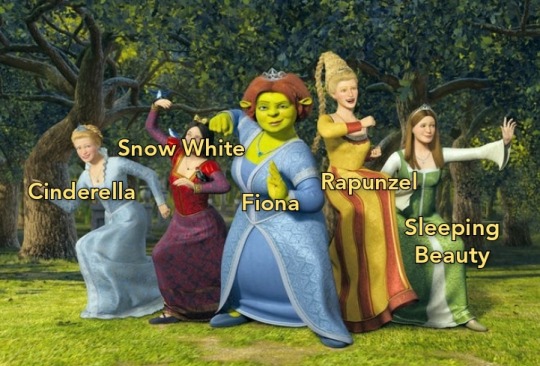

I assume this was done to avoid a lawsuit from the mouse. Still, it's kinda hilarious that Dreamworks made their princess line when the entire point of the shrek series is to poke fun at Disney's ultra-corporatism.
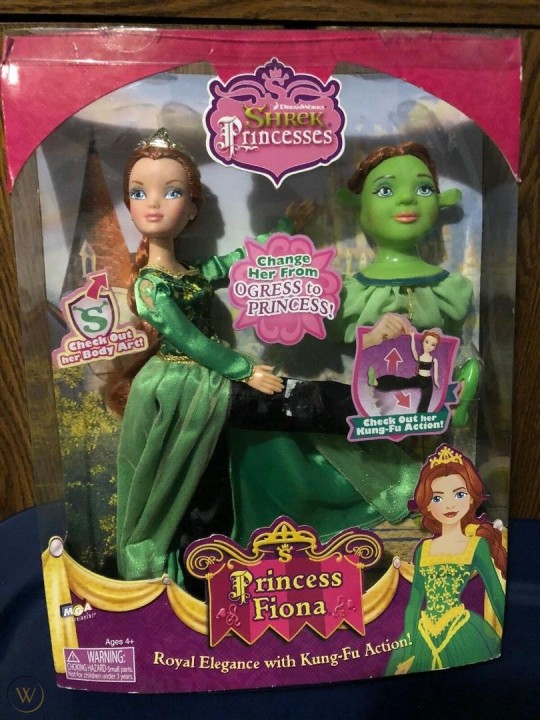
First Fiona. Her doll form is her human form and included a bust of her Ogre form to change heads. She has her green gown which is the iconic item in her wardrobe. Her face does NOT look accurate to her human appearance in the movie!
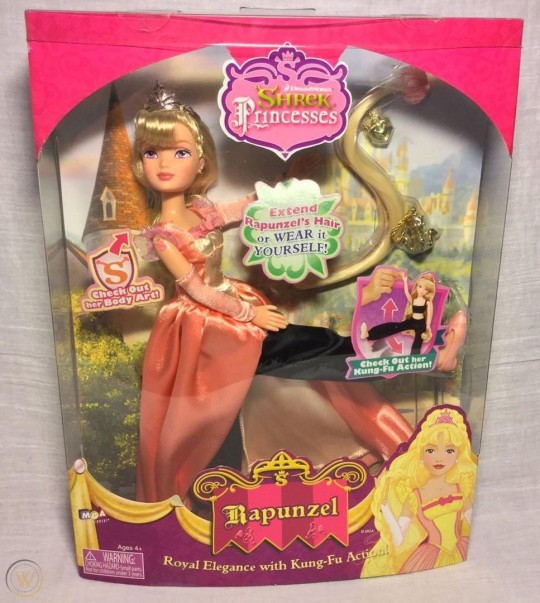
Next we have Rapunzel. Her doll keeps the long golden hair but in a different style. In the movie she wore a yellow&red dress while the doll's dress is pink. Odd, given the other two princesses wear pink. Yellow would've stood out more. I got her & Cindy mixed up!

Third is Cinderella. Like with Rapz her doll form retains the blond and replaces her blue dress with pink. Funny the Disney version had its version of cindy wear a pink dress briefly.
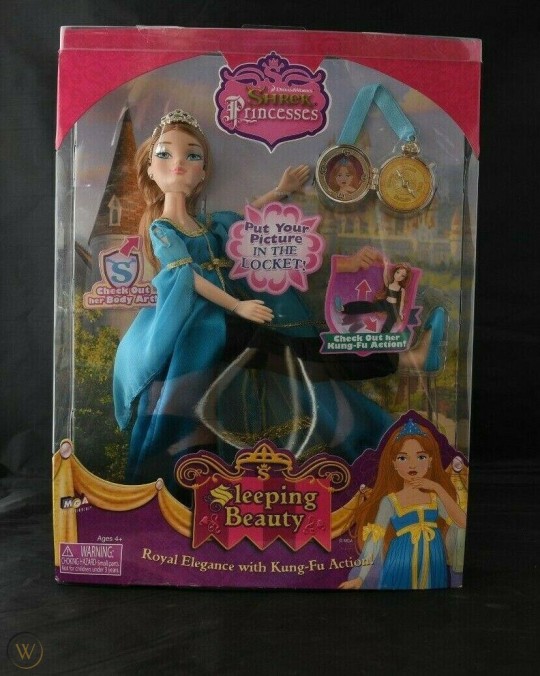
Fourth is Sleeping Beauty! Her doll has a blue dress while the movie wears green&white. They also have different shades of brown. I guess they didn't want two girls to wear the same color. Also a bit of irony Disney S.B. wore a blue dress, and pink but never green.
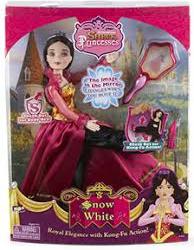
Finally we have *sighs* Snow White. Honestly except for Immigrant Song she was my least favorite she came off as a total witch! But that's a rant for another time. Of the dolls she's the most accurate in terms of physical features. However her dress is dark pink, and her hair is long instead of short. Movie Snow wore red&purple. I think they should've went with that or have her wear entirely purple to fill in for Doris.

Speaking of, Doris was very much a main part of the group! It was Rapunzel who betrayed the team (for a guy no less!). My guess: to avoid spoiling the film. Given the films Anti Disney/status quo message including a Doris would've helped. To see someone not consisted attractive by society's standards get a glamorous doll of her own would be a huge step for the time! Alas, they had to play by the rules.
One can only imagine if DW revisit the Princesses & try again. Hope they actually make them accurate with their unique qualities including doris (& Lillian too! More older woman dolls please!). With success of The Last Wish, this may be one dream that might come true!
#mga entertainment#mga dolls#shrek#shrek princesses#sleeping beauty#snow white#rapunzel#cinderella#princess fiona#doris#queen lillian#dolls#dollblr#dolltwt#doll community#dreamworks animation#international women's day 2023#women's history month
242 notes
·
View notes